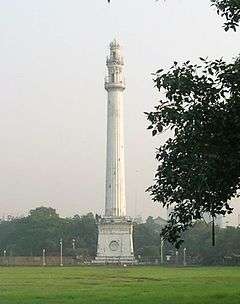Maidan (Kolkata)


The Maidan (literally, open field), also referred to as the Brigade Parade Ground,[1][2] is the largest urban park in Kolkata in the Indian state of West Bengal. It is a vast stretch of field that includes numerous play grounds, including the famous cricketing venue Eden Gardens, several football stadiums, and the Kolkata Race Course. The Maidan is dotted with statues and architectural works, the most notable being the Victoria Memorial. Due to the freshness and greenery it provides to the metropolis, it has been referred to as the "lungs of Kolkata".[3] The property of the Indian Army, the Maidan hosts the army's Eastern zone high command in Fort William. The Maidan stretches from the Raj Bhavan building on the Esplanade in the north to the National Library on Belvedere Road in Alipore in the south. The wide field stretches from the Hoogly River in the west to the Victoria Memorial in the east. It is a historical and cultural center of Kolkata as well as a center of leisure and entertainment for Calcuttans.
History
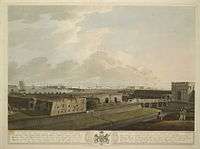
.jpg)
In 1758, one year after their decisive win in Battle of Plassey, the British East India Company commenced construction of the new Fort William in the center of the village Gobindapur. The inhabitants of the village were compensated and provided with land in Taltala, Kumartuli and Shovabazar. The fort was completed in 1773.
The tiger-haunted jungle which cut off the village of Chowringhee from the river was cleared, and gave way to the wide grassy stretch of the Maidan of which Calcutta is so proud. The formation of this airy expanse and the filling up of the creek which had cut off the settlement in the south, led the European inhabitants to gradually forsake the narrow limits of the old palisades. The movement towards Chowringhee had already been noticeable as early as 1746.[4]
In 1883–1884 the Maidan, along with grounds of the Indian Museum, hosted the Calcutta International Exhibition.[5]
In 1909, H.E.A. Cotton wrote,
The great Maidan presents a most refreshing appearance to the eye, the heavy night dew, even in the hot season, keeping the grass green. Many of the fine trees with which it was once studded were blown down in the cyclone of 1864. But they have not been allowed to remain without successors, and the handsome avenues across the Maidan still constitute the chief glory of Calcutta. Dotting the wide expanse are a number of fine tanks, from which the inhabitants were content in former days to obtain their water-supply.[6]
Army property
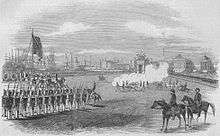
The Maidan was initially developed as a 5-square-kilometre (1.9 sq mi) parade ground for the forces.[7] While the Europeans moved to the area around the Maidan, the Indians moved away. The richer families such as the Debs moved to Sobhabazar, the Tagores to Pathuriaghata and Jorasanko, and the Ghosals to Bhukailash (Khidirpur).[8] The Maidan has been with the army since it was developed; they are the owners, but administration of the Maidan was one of the duties of the police. Thieves, both Indian and European, were there as early as the 1860s.[9] Legally, the fort and the Maidan were excluded from the city as per Act 16 of 1847.[10]
Around the Maidan
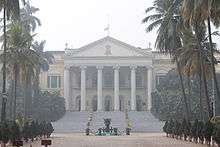
While the core of the Maidan has remained untouched except for roads and tram tracks across it, the surrounding areas have undergone significant construction activity. In 1882, the Calcutta Tramways Corporation introduced steam-powered trams across the Maidan from Chowringhee to Kalighat and Khidirpur. In 1889 came the electric trams.[11]
The oldest road on the Maidan is the Course, extending from the 'Cocked hat' in the north to the Khidirpur bridge. The 'broad gravelled walk' on the west side of that portion is the Red Road, constructed in 1820. To the south of the fort is the Ellenborough Course, meant for horse exercises, and towards the east is the Race Course, started in 1819. That was the scenario a century back.[6]
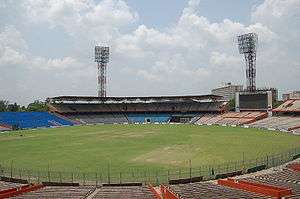
Government House was built in 1803, the 48-metre (157 ft) high Octerlony Monument in 1848,[12] the museum was started in the Asiatic Society in 1814 but shifted to the present site as the Indian Museum in 1887,[13] St. Paul's Cathedral was built between 1839 and 1847, it was consecrated in 1874,[14] and the Victoria Memorial was erected in 1921.[15] On Council House Street, at one corner of the Maidan, was the long-defunct Fort William College,[16] which played a pioneering role in the development of many of the Indian languages, particularly Bengali.
The cricket stadium at Eden Gardens was built in stages. Amongst the later additions are Netaji Indoor Stadium, the M. P. Birla Planetarium,[17]Rabindra Sadan, the Academy of Fine Arts, and Nandan.
Chowringhee, part of the north-south lifeline of Kolkata, was laid down at the same time as the Maidan along what was the old road made by the Sabarna Roy Choudhurys, the old zemindars of Calcutta, from Barisha, where the junior branch resided, to Halisahar, which was the seat of the senior branch.[18] The Tollygunj–Esplanade section of the Metro Railway took a little over seven years to build, all the while disturbing activity on the eastern end of the Maidan.[19] The stations bordering the Maidan as one travels from the south are Maidan, Park Street, and Esplanade.
The Howrah Bridge is away from the Maidan, but the second Hooghly bridge, Vidyasagar Setu, overlooks at least one corner of the Maidan and Fort William.
Statues
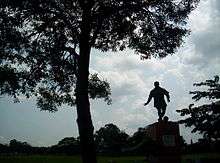
The Maidan was dotted with statues of British governor generals and other eminent personalities of the British Raj, includingLord Curzon, Kitchener, Roberts, Minto, Northbrook, Canning, and others who had known Kolkata well. Two or three of them were erected in the first few years of Indian independence in 1947; it was not until 1983 that the last 16 were removed.[20] Over time, many of the vacant plinths or plots were filled with statues of Indians, including Mahatma Gandhi, Ram Mohan Roy, Chittaranjan Das, Jawaharlal Nehru, Subhas Chandra Bose, Sri Aurobindo, Matangini Hazra, Pritilata Waddedar, Indira Gandhi, Gostho Pal, and others. At the northeast corner of the Esplanade stands a statue of Vladimir Lenin, set up to celebrate the centenary of his birth.[21]
Events
Political rallies
Geoffrey Moorhouse in 1978 presents a vivid description of a Communist Party of India (Marxist) (CPI(M)) rally on the Maidan:
They generally start about tea time, they rarely finish before nine o’clock… they are masterly exhibitions of organisation… The platform is high so that everyone on it will be visible at a great distance, and it is large enough to accommodate twenty or thirty… it is illuminated with spotlights, it flutters with red flags, and it has huge red backcloth upon which Lenin is straining resolutely forward from a thicket of banners. Everything is perfectly under control… as they sit there upon the ground, row after attentive row of them, a brigade of young women to the fore… distantly across the Maidan people have climbed trees and others are packed standing on top of the Esplanade tram shelters… there must be a hundred thousand here altogether… the leaders come through the guard of honour to the platform…it is only when Promode Dasgupta and Hare Krishna Konar are having their say… theirs is the oratory that sends men delirious with dreams, that can set a rabble to a march of destruction… when the speeches are done, the leaders begin to sing the Internationale… all over the crowd torches are swiftly lit and held high in flaring salute…[22]
The Maidan has been the venue for major political meetings and rallies of all political parties. However, cleaning up the Maidan after a rally is over has become a sore point. The army authorities have decided to levy a caution money from organisers of the rallies and an undertaking to clear the litter in a bid to make the Maidan pollution-free.[23]
Book fair controversy
The Maidan had been the site of numerous fairs and exhibitions including the Kolkata Book Fair, Handloom Expo, Industrial India Trade Fair, Travel and Tourism Fair, Vidyasagar Mela, and Lexpo.[24] One of the reasons is that nobody has taken the lead to develop in Kolkata an exhibition ground similar to Delhi's Pragati Maidan.[25] With thousands of people attending the fairs, the question of pollution came up and public interest litigations were filed. The army authorities were alerted. They, too, started pushing to shift the fairs to some other site, possibly on the Eastern Metropolitan Bypass. Even the book fair, which was thought of as a cultural event, came under fire. One visitor quipped in 2003: "It’s not the Kolkata Book Fair anymore. It's the Big Bazar, and the trend is here to stay."[26] When in 2003 the 17th Industrial India Trade Fair with 700 exhibitors came to a close, it had drawn in over 800,000 visitors. The commerce and industries minister, Nirupam Sen, announced a plan to construct a permanent fairground off the EM Bypass. He confirmed that the Bengal National Chamber of Commerce and Industry, one of the co-organisers of the fair, has expressed its willingness to be a part of the project.[27]
When the curtains came down on the 29th Kolkata Book Fair in 2004, with a record attendance of 2,475,000, the organisers announced that they had already applied to the police commissioner and defence authorities for permission to hold the fair the following year.[28]
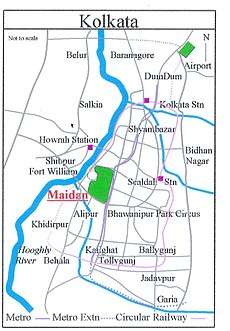
In 2005, The Statesman, a leading Kolkata newspaper wrote,
The Kolkata Book Fair may well have had its last outing on the Maidan… In recent years, almost every part of the Maidan has been used to host all manners of melas and fairs. This, obviously, can't continue… Our courts of justice are now taking cognizance. The military too has woken up to its environmental responsibility. Even business houses have apparently become concerned. At this rate, it might seem the lungs of Kolkata, and of the people who inhabit it, still have some hope.[29]
With both the chief minister and the chief secretary assuring that it was the last year that fairs were to be held at the Maidan, as the permanent trade fair complex along the Eastern Metropolitan Bypass – thereafter the venue for trade fairs, the Kolkata Book Fair, and other fairs – was yet to be completed, the army authorities allowed the Book Fair to be held on the Maidan for the last time in 2006.[30]
The drama to organise the book fair on the Maidan started again in 2007, but the Kolkata High Court issued a ruling against allowing the Kolkata Book Fair to be held at the Maidan.[31] The Book Fair was eventually held in the Yuba Bharati Krirangan in 2007.[32] Other fairs were shifted out earlier.[33] However, there are people who think that the Kolkata Book Fair cannot be properly organised except on the Maidan.
The Maidan in the Bengali psyche
When Bethune (1801–1851), in 1859 set up the girls' school that later bore his name, the noted Bengali poet of the period, Ishwar Chandra Gupta (1812–1859) focussed the spirit of public indignation as follows:
- jato chhunrigulo turi mere ketab hatey nichhey jabey,
- A B sikhey, bibi sejey, bilati bol kabei kabey;
- aar kichhu din thakrey bhai! pabei pabe dekhte pabe,
- apon hatey hankiye bogey, garer maatthey haoa khabey.
(When all the lasses have started learning the alphabet, picking up the book, feigning to be English ladies, they will definitely splash the tongue foreign; Brothers, wait for a few more days! And you will be able to have a look, they will drive to the grounds of the fort for roaming around, commanding the rein.)[34]
People did not have to wait for long. After Jyotirindranath Tagore (1849–1925) taught his wife, Kadambari, horse-riding on the Maidan in defiance of the conservative society of the time, Bengali society would never be the same again.[35][36]
During the British Raj, white soldiers were stationed in Fort William. When they came out on the Maidan for strolls, they used to kick Bengali boys they found on the Maidan. The boys were too timid to protest. Sarala Devi Chaudhurani (1872–1945) was deeply shocked at the cowardly behaviour of the youngsters. She introduced the Birastami brata as part of Durga Puja wherein youngsters took the oath to stand up bravely against all sorts of oppression. It subsequently inspired the youth of the country to lay down their lives in the freedom struggle.[37]
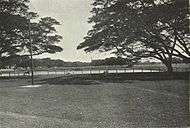
Life on the Maidan

The roads on the Maidan are dotted with tiny greenish bungalows (club houses) belonging to sports clubs. There are patches for playing. Some of the larger clubs occupy the fields with wooden galleries. The big three of Kolkata football – Mohun Bagan, East Bengal, and Mohammedan Sporting have a noticeable presence. There are also names with faded glory such as the Rangers. Lying somewhere in between are organisations such as the Kennel Club and Press Club. There are lower order clubs, who do not have much of a following but have a noticeable contribution and sometimes spring a surprise – Wari, Aryans, Rajasthan and so on and a host of office clubs.
Indian cricket began its long journey with a two-day match on the Maidan in January 1804 between old Etonians employed by the East India Company.[38] The world's oldest hockey tournament, Beighton Cup, was instituted in 1895 and is usually held on the Mohun Bagan ground in the Maidan.[39] For the Indian Football Association, the Maidan has been the nerve centre.
The Maidan is not just cricket, football, and hockey, apart of course from army parades. It is so many things to so many people. There are washermen who wash clothes and themselves in its ponds, shepherds who tend their flocks,[38] the health conscious citizens taking their morning walks, and the last vestiges of the horse-drawn hackney carriages plying its fringes entertaining merrymakers and businessmen to make money. When Jamshedji Framji Madan entered the 'bioscope' scene in 1902, he began to screen films in tents, one of which was set up on the Maidan.[40] In Satyajit Ray's film Jana Arayanya there is a shot showing two unemployed young men, observing the sprawling urban comedy around them on the Maidan, identify the typical office clerk in the crowd. He is presented in a long shot, puny against the towering, squalid cityscape, trudging home after a nine-to-five day.[41] Life on the Maidan is the quintessence of life in Kolkata.
Police district
Maidan police station is part of the South division of Kolkata Police. Located at 1/5, Acharya Jagadish Chandra Bose Road, Kolkata-700020, it has jurisdiction over the police district which is bordered on the north from the south-west corner of the junction of Strand Road and Sahid Khudiram Boase Road (old Auckland Road) thence crossing Strand Road eastwards up to the south-east corner of the junction of Strand Road and Sahid Khudiram Bose Road, thence eastward along the southern limit of Sahid Khudiram Bose Road up to the south-west corner of the junction of Sahid Khudiram Bose Road, Government Place West and Lawrence Road, thence south-ward along the western limit of Gostho Pal Sarani (old Eden Garden Road) up to its junction with Rani Rashmoni Avenue from Plassay Gate Road to south-east corner of its junction with Guru Nanak Sarani thence northward along the eastern limit of Government Place East up to its junctions with Rani Rashmoni Road thence eastward along the southern limit of Rani Rashmoni Road up to the southwest corner of the junctions of Rani Rashmoni Road and Jawaharlal Nehru Road.[42]
It is bordered on the east from the south-west corner of the junction with Rani Rashmoni Road and Jawaharlal Nehru Road thence southward along the western limit of Jawaharlal Nehru Road up to the north-west corner of its junction with extended part of Queens Way.[42]
It is bordered on the south from the north-west corner of the junction of Jawaharlal Nehru Road and extended part of Queens Way, thence westward along the northern limit of Queens Way up to the junction of Queens Way, Pranabananda Sarani and Lovers Lane, thence northward along the eastern limit of Lovers Lane up to the south-east point of the junction of Lovers Lane and Khidderpore Road, thence crossing Khidderpore Road north-ward along a shortest line up to a point on the northern limit of Khidderpore Road, thence towards south-west direction along the northern limit of Khidderpore Road up to the north-east corner of the junction of Khidderpore, Acharya Jagadish Chandra Bose Road and St. Georges Gate Road, thence northward along the eastern limit of St. Georges Gate Road up to a point on the north-west corner of the junction of St. Georges Gate Road and Commissariat Road, thence crossing St. Georges Gate Road westward up to the north-west corner of the junction of St. Georges Gate Road Commissariat Road, Thence along the northern limit of Commissariat Road up to the northwest corner of the junction of Commissariat Road and Clyde Rowm thence westward along the eastern limit of Clyde Row up to the northeast corner of the junction of Clyde Row and Napier Road.[42]
It is bordered on the west from the northeast corner of the junction of Clyde Row and Napier Road up to the junction of Napier Road and Strand Road, near Marine House, thence along Strand Road (Road excluded) up to the extreme southern end of Outram Ghat, thence crossing Strand Road it runs along the western limit of Strand Road up to the southwest point of the junction of Strand Road and Sahid Khudiram Bose Road.[42]
See also - Maidan police district map
Tollygunge Women's police station has jurisdiction over all the police districts in the South Division, i.e. Park Street, Shakespeare Sarani, Alipore, Hastings, Maidan, Bhowanipore, Kalighat, Tollygunge, Charu Market, New Alipur and Chetla.[42]
Coordinates: 22°33′4.70″N 88°20′49.96″E / 22.5513056°N 88.3472111°E
References
- ↑ "Trinamool set for 'biggest' Brigade rally". The Times of India. 29 January 2014. Retrieved 2014-03-01.
- ↑ "Brigade Parade Ground to host 3 mega rallies by TMC, BJP & LF". 29 January 2014. Retrieved 2014-03-01.
- ↑ Yardley, Jim (27 January 2011). "In city's teeming heart, a place to gaze and graze". The New York Times. New York. Retrieved 27 November 2011.
To Kolkata, it is the 'lungs of the city,' a recharge zone for the soul.
- ↑ Cotton, H.E.A., Calcutta Old and New, 1909/1980, p. 72, General Printers and Publishers Pvt. Ltd.
- ↑ "Retro look: unseen shots of 1883". Retrieved 4 January 2017.
- 1 2 Cotton, H.E.A., pp. 220–221.
- ↑ Cotton, H.E.A., p. 3
- ↑ Cotton, H.E.A., p. 11
- ↑ Cotton, H.E.A., p. 242
- ↑ Chakraborty, Satyesh, The Growth of Calcutta in the Twentieth Century, in Calcutta, the Living City, Vol. II, edited by Sukanta Chaudhuri, 1990/2005, p. 2, Oxford University Press, ISBN 0-19-563697-X.
- ↑ Cotton, H.E.A., p. 235
- ↑ "Shahid Minar (Ochterlony Monument)". kolkatainformation.com. Retrieved 2007-05-04.
- ↑ "Indian Museum Kolkata". The Official Website. indianmuseumkolkata.com. Archived from the original on 23 November 2006. Retrieved 4 May 2007.
- ↑ "Calcutta Sight Seeing". indiatravelite.com. Retrieved 2007-05-04.
- ↑ "The Official website of Victoria Memorial Hall, Calcutta". The Official Website. victoriamemorial.com. Archived from the original on 19 May 2007. Retrieved 4 May 2007.
- ↑ Cotton, H.E.A., p. 271
- ↑ "M.P.Birla Planetarium". The Official Website. education.vsnl.com. Archived from the original on 14 April 2007. Retrieved 2007-05-04.
- ↑ Cotton, H.E.A., p 283.
- ↑ Roy, Tathagata, The Calcutta Metro, in Calcutta, the Living City, Vol. II, p. 158
- ↑ Moorhouse, Geoffrey, Calcutta, the City Revealed, first published 1971, Penguin Books 1986 edition, p. 227, ISBN 0-14-009557-8
- ↑ Moorhouse, Geoffrey, p. 329.
- ↑ Moorhouse, Geoffrey, pp. 154-155
- ↑ "Go-ahead for rallies likely". Bengal. The Statesman, 23 December 2005. Archived from the original on 29 September 2007. Retrieved 2007-05-07.
- ↑ "Fairs in Kolkata". Travel in Kolkata. www.kolkatahub.com. Retrieved 2007-04-23.
- ↑ "Maidan reprieve Left's policy on fairs under fire". Editorial. The Statesman, 16 December 2003. Archived from the original on 29 September 2007. Retrieved 2007-05-07.
- ↑ "The big Book Fair bazaar". World. The Statesman, 4 February 2003. Archived from the original on 29 September 2007. Retrieved 2007-05-07.
- ↑ "Trade fair draws to a close". Kolkata Plus. The Statesman, 31 December 2003. Archived from the original on 29 September 2007. Retrieved 2007-05-07.
- ↑ "Curtain down on the book fair with death". Kolkata Plus. The Statesman, 9 February 2004. Archived from the original on 29 September 2007. Retrieved 2007-05-07.
- ↑ "Mourning the death of Boi Mela". Perspective. The Statesman, 22 February 2005. Archived from the original on 29 September 2007. Retrieved 2007-05-07.
- ↑ "Maidan fair ground again". Perspective. The Statesman, 17 November 2005. Archived from the original on 29 September 2007. Retrieved 2007-05-07.
- ↑ "Foul is not fair". Editorial. The Statesman, 31 January 2007. Archived from the original on 29 September 2007. Retrieved 2007-05-07.
- ↑ "Book Fair in Salt Lake from 10 to 21 Feb". Page One. The Statesman, 1 February 2007. Archived from the original on 29 September 2007. Retrieved 2007-05-07.
- ↑ "Trade Fair shifted to Bidhannagar". Bengal Plus. The Statesman, 18 January 2007. Archived from the original on 29 September 2007. Retrieved 2007-05-07.
- ↑ Sastri, Sivanath, Ramtanu Lahiri O Tatkalin Banga Samaj, (in Bengali), pp. 113–114, New Age Publishers Pvt. Ltd.
- ↑ Ahmed, Wakil (2012). "Tagore, Jyotirindranath". In Islam, Sirajul; Jamal, Ahmed A. Banglapedia: National Encyclopedia of Bangladesh (Second ed.). Asiatic Society of Bangladesh.
- ↑ Deb, Chitra, Jorasanko and the Thakur Family, in Calcutta, the Living City, Vol I, edited by Sukanta Chaudhuri, p. 66, Oxford University Press, ISBN 0-19-563696-1
- ↑ Banerjee, Hiranmay, Thakurbarir Katha, (in Bengali), p. 212, Sishu Sahitya Sansad.
- 1 2 Moorhouse, Geoffrey, p. 228
- ↑ "Beighton Cup". bharatiyahockey.org. Retrieved 2007-04-13.
- ↑ Banerji, Samik, The Early Years of Calcutta Cinema, in Calcutta, the Living City, Vol. II, p. 294.
- ↑ Biswas, Moinak, Modern Calcutta Cinema, in Calcutta, the Living City, Vol. II, p. 304.
- 1 2 3 4 5 "Kolkata Police". South Division. KP. Retrieved 12 March 2018.
External links
| Wikimedia Commons has media related to Maidan, Kolkata. |

